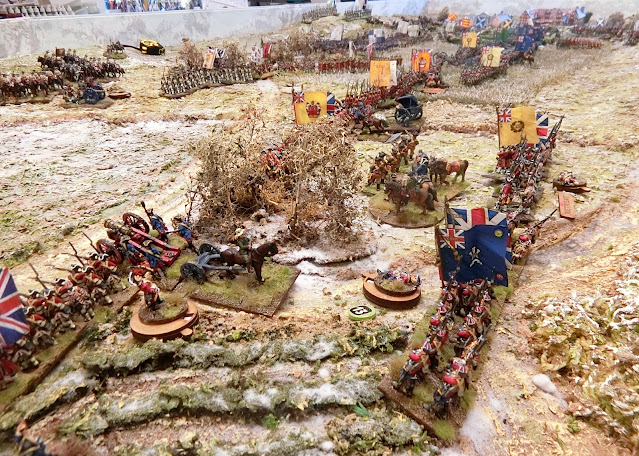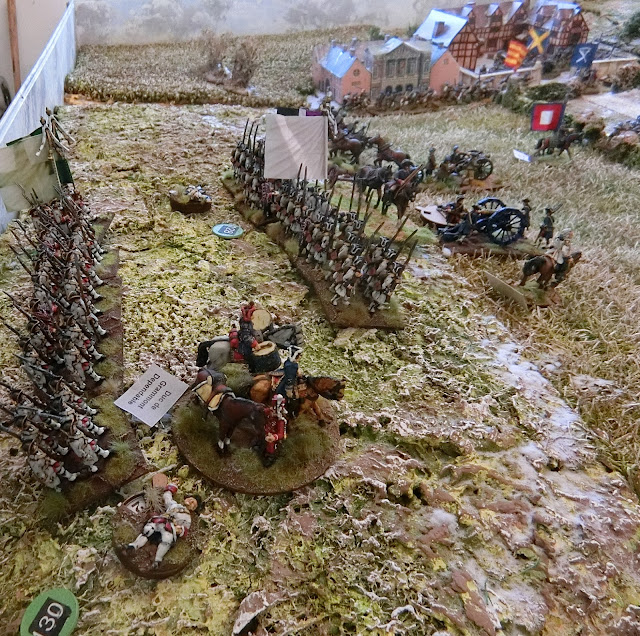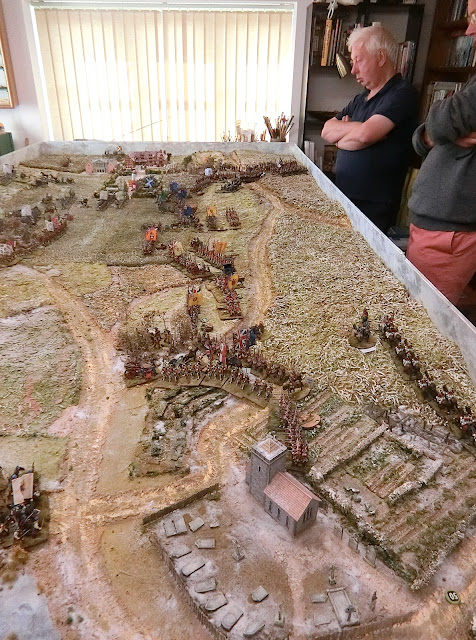I hope you have enjoyed this short series so far. If you need a reminder of this, the biggest battle in Guy's "what-if" Jacobite Rebellion, the previous part is here.
(As before - main text by Guy Barlow, explanations in picture captions, and helpful asides in italics (!), by me)
Day Two
The first five moves on this mid -Winter "Boxing Day" had taken us from 8am to mid morning, but with 1200 figures for the two players and their "umpire-assistants" to deal with it had taken us all of the first day 's play to get that far. "Bonnie Prince Charlie" for that Day One was Ken Marshall who could not manage a whole weekend this time. So Steve Johnson came up from South of Bristol for the day and picked up the Young Pretender's "Crown".
At this point the Scots/French force, though it had suffered a lot, was gaining momentum and merely lacked overwhelming strength in any one sector. Richard/Duke of Cumberland was defending well but his line was shrinking. Guy and I had to figure out what to do about the reserve brigades we had lined up for each side. With Steve/Prince Charlie obviously wanting a good game I was in favour of bringing the French reserves on very quickly so he would have the confidence to attack. To balance this I proposed that Cumberland receive a message telling him his reserves had been delayed and suggesting that he save the army by an orderly withdrawal. Knowing Richard of old I guessed he'd make a professional, well controlled and 18th century style attempt at this while being heavily pressed.
Guy had other ideas though, and he wanted to prevent an outright victory for either side in order that his campaign could continue on to his desired dénouement somewhere nearer London. So Guy wrote two hand written messages (see them here) which we gave to the respective commanders, who obviously had no idea of our actual deliberations. Neither did I really, as Guy kept his "neutral" intention close to his chest and trusted in the players' interpretation of his solicitor-speak letters and the fate of the dice! He knew neither side would get reinforced today!
CG
 |
| View near the start of Day Two, a detailed tour in the photos below |
 |
| No matter how "serious" the game it seems to be laughter all the way when Steve's at my table! |
 |
| The government left flank cavalry had either died, fled or were just retreating disconsolately. The villagers of Harleston were now the last bastion holding the flank! |
 |
| The line of regular troops ended at Harleston Church with a worn Grenadier battalion |
 |
| Reforming government units form the second line near Duke Ferdinand of Brunswick's left-central position |
On with the narrative by Guy:
Turn 6
<<We were then moving towards the climax of the battle. Despite winning the initiative, the French commander allowed the government forces to move first. This was unforeseen and led to much rather rude Gaelic mutterings from the flanks (by CG as assistant!). The government forces had received orders that their overriding mission was not to imperil the army or allow it to be defeated. Further, a message had arrived saying that the government reinforcements had sighted and were shadowing the French reinforcements and both sides were unlikely to see fresh troops.
The Government forces therefore started a modest withdrawal to strengthen and consolidate their lines. The shortened frontage only made the task of the Jacobites harder. Meanwhile, the Jacobites pressed on by attacking the mortar battery, but in a true Samson v. Goliath moment the plucky British gunners picked up their muskets and somehow survived to be able to withdraw and reform.
There was further ongoing considerable attrition in the Franco/Jacobites ranks. In the West, inferior lowland units tangled with the 1st Foot Guards in the gardens and exchanged volleys, with the inevitable result. More French units were lost in the centre from ongoing artillery attrition. The result was that gaps started to appear in the French lines which had to be plugged by reserve infantry and some small Scots and French cavalry units .
 |
| In the centre the Grenadiers de France break under canister fire from two light batteries |
 |
| Steve's allowing his opponent the initiative meant Richard had the chance to bolster up that weak point opposite the French cavalry...... |
 |
| ......who would soon be taking casualties from long range artillery fire |
 |
| At Harleston the one remaining government cavalry regiment heads towards the centre to find more fruitful cavalry ground |
 |
| Each government brigade had a battery of light guns. Combining with the threat of musketry volleys it meant that nowhere in the central area was safe for the French to attack |
 |
| By the Hunting Lodge woods a German mercenary battalion was the next unit to break from long range attrition |
 |
| .....but they were easily pushed back by the elite infantry |
 |
| French casualties from an earlier hour are being recovered from under the influence of the French Commander in Chief |
 |
| Reformed Highland clans on the Jacobite right now return to the scene of action. The villagers of Harleston await the onslaught with trepidation |
Turns 7 -8
Artillery continued to fire along the lines with the government guns rather more effective than the inferior Jacobite ones. At the NW corner of the battlefield there was a last highland charge against the 43rd Foot (an inferior regiment here today and subsequently became the Black Watch). The 43rd were supported by 2 units which allowed them to send the highlanders back, although they also had to retire. A fresh British unit filled the line.
 |
| On the other extreme flank a similar Jacobite charge went in against the loyal Scots 43rd Foot..... |
 |
| .....however this wider view shows that a mixture of setbacks, reforming and close terrain had inhibited Steve's ability to get enough troops up the ridge quickly. That icy pond was a nuisance. |
 |
| This clan under the Earl of Cromartie was broken, and so too was the 43rd. But the government line had plenty of reinforcements at this end |
 |
| Richard doesn't look very happy, but in fact by late morning on this Boxing Day the battle was turning in his favour |
 |
| View from the French cavalry's position, where the front unit has already sustained 3 Hits......... |
 |
| .....with de Saxe Lancers by their side and Baggot's Hussars and the Princes Lifeguard waiting to give support; meanwhile the Scots guns pound away wherever there is a gap |
 |
| Near the centre the French are once again on the advance, trying to support the faster moving Scots |
 |
| Le Duc de Grammont backs up the advance bringing forward his reformed battalions |
 |
| Above and below: the advance from the Hunting Lodge of the Foreign Service brigade under the Marquis de Souvre constantly met a wall of British fire. Now Lally's Irish regiment falls victim to it |
 |
| The French Guard Brigade had not been able to make any progress, maybe now there was a gap for them? |
Turns 9 - 10
In the rest of the line, the government commander continued to hold his position and the Franco/Jacobite force after a modest advance against the village of Harleston to eject some troublesome yokels armed mostly with scythes, came to the conclusion that victory was not going to be achieved that day.
All, however, was not lost. The Jacobite army was still between Cumberland and London. The Jacobites had severely mauled the government cavalry which meant there was no pursuit. In the fading light the Franco/Jacobite army withdrew, and the 2 armies lost contact.
 |
| On the Althorp Manor flank the Jacobite thrust up the ridge was looking distinctly lacking too |
 |
| Cumberland has managed to steady his line, but it's still scrappy and nearly all these battalions have suffered hits. It's now about 1 pm and several have been in action since 8 am |
Aftermath
The government forces were left in possession of the field which allowed Cumberland to claim a victory but………..
It was certainly not a crushing defeat of the rebels as demanded by the King. Large quantities of ammunition had been expended and supplies were running low. The Jacobites were now between them and London, their principal point of supply.
The result was also not particularly satisfying for the Prince. Whilst the combined Franco/Jacobite army had fought well, and at one stage certainly seemed to have the government forces on the ropes, it was perhaps illusory. The government battle lines had never really been challenged and a number of fine French infantry regiments had been destroyed. For the first time in the campaign his troops had not achieved an overwhelming victory. The British/Hanoverian government troops from the continent were certainly a far tougher nut to crack than the troops he faced at Prestonpans and Brampton. The Prince could only claim that they had given Cumberland a bloody nose and the army had withdrawn intact to fight another day.
However, he has nagging doubts whether the French are trusted allies and will continue to support him? Whilst the route to London is effectively open, if a council of war proposes a retreat to Scotland, this may now be problematic from a purely geographical perspective. Retreat northwards may not be an option.
One way or another, the campaign continues. The rebels are still loose in central England and the throne is still threatened.
Postscript
Ferdinand of Brunswick once again received glowing compliments from the King and the army for his steadfastness.
The Hon John Spencer crawled out of his priest’s hole to survey the devastation of his house. He took the decision that day to rebuild Althorp. The stable boys and villagers called him Hon Cringeling behind his back. He became aware of these derogatory comments and the villagers Christmas boxes were cancelled in 1746. For decades the stories of the stable boys and villagers’ valour multiplied in the local public houses to the extent that in the local folklore, the battle was solely between the hearty sons of Northamptonshire and Scots.
The British cavalry were again the subject of much criticism. A duel was fought after a Guards subaltern referred to them as donkey wallopers. The name stuck.
The Jacobite troops in the main were further emboldened by their performance and the success of the highland charge. They failed to appreciate one of the lessons of the battle, i.e. the Franco/Jacobite units had great difficulty advancing and breaking a formed British infantry line supported by artillery. They continued to maintain the effectiveness of the highland charge as a battle winning tactic.
Post battle - the campaign goes on
The Franco/Jacobite forces manoeuvred to join with their covering forces at St Neots and a Council of War was called to decide which direction the army should move. Various options were proposed – a fast advance and attack on London, an indirect advance through East Anglia which would have the advantage of resupply by the French ships, a withdrawal to Scotland, or a march towards Oxford and the Southwest.
The Government forces dispatched their remaining cavalry to discover where the Jacobites had gone. No conclusive news was forthcoming. Cumberland therefore ordered a forced march towards London. Perhaps the truest indication of what happened was seen in the City of London. The value of Government securities lurched downwards, and gold was in huge demand. Hysteria gripped the streets as rumoured sightings of hairy Scotsmen on Hampstead Heath circulated. The ladies of fashion dusted off their Parisian decolletage gowns and the gentlemen their bottles of Sauternes...........
(by CG) Finally, I need to pay tribute to Guy. He deserves great credit for putting together such a complicated scenario, providing most of the ideas and 95% of the figures which made it to the tabletop, compiling the briefs and orbats (under guidance from me), and being lead umpire for two days. Thanks a lot Guy, wonder what next year will bring?
















It's been a joy to follow this campaign, the table, the miniatures, the whole thing has been top notch. Guy really did a superb job on getting it done, but massive kudos to you all on such a treat for the eyes!! Really enjoyed your posts Chris, great stuff!!
ReplyDeleteThanks so much for your praise Donnie and pleased you enjoyed them all
DeleteA fine last instalment to the game there Chris:). Some really lovely photos there as always that immediately took me back to the action. Interesting to note the losses at the end, some of which I think occured as the Franco-Jacobite forces desperately tried to break that solid Anglo-Hannoverian line towards the end of the game. The mortar unit certainly deserved the man-of-the-match award for sure!
ReplyDeleteWhat can I say, Chris? Your games and table layouts are truly works of art. Stunning.
ReplyDeleteGreat that you find them worthwhile Jonathan, and thanks for always supporting this blog no matter what period we are doing
DeleteA fine piece of wargaming. Congratulations to Chris and Guy in particular for the pay-off for all the hard work.
ReplyDeleteSteve's disgraceful national stereotyping of the Scots, as seen in his final message, deserves to be heartily condemned by all thinking wargamers. Especially as he never could do a decent Scot's accent.
Thanks a lot Keith. In Steve's defence the fun interviews at the end were entirely my own fabrication! CG
DeleteThanks so much for episode 3. Your photos are miles better than mine and are a happy reminder of a great weekend of gaming. There will be hopefully one last dénouement engagement in this campaign. No more campaign fudging - both the Prince and the King require an all-out conclusive win. One of them will be going through Traitor's Gate in the Tower and there will be a second example of regicide in a century.
ReplyDeleteI will e-mail you with some ideas which the dog and I have come up with. We will then plot and plan.
Guy
Really look forward to hearing about that Guy. Your dog is brilliant at wargame scenarios :-)
DeleteAnother fantastic AAR, full of wonderful battle images of 18th century fighting.
ReplyDeleteMerry Christmas, happy New year and happy gaming.
Willz.
You are always a great source of support for this blog Willz thank you. And the Compliments of the Season to you too
DeleteWell this series has been superb. The table, I think, is one of the best I have seen ( surely a Christmas card front must be in there somewhere.) The figures look excellent and the effort Guy has put into the campaign etc is to be applauded ( sorry I sold my collection!) I have thoroughly enjoyed these accounts. I intend to re read them and look even more intently at the photos. Congratulations Chris on building the table and hosting the event.
ReplyDeleteThanks sincerely Graham for your extensive comment and appreciation. I think it is a lot down to your support via Crann Tara that Guy amassed such a wonderful collection. Well, we've asked the purchaser of your collection if he'd like to combine for a big game at mine sometime in the future...we shall see. As for the Christmas card I rather hoped my seasonal snowy heading might do? Yours will be a bit spicier if/when Royal Mail can deliver it :-)
ReplyDeleteThis series of posts is fantastic. The terrain, figures and associated game narrative is pretty much what this hobby is all about. Now I need to put Graham's collection to good use, I couldn't wish for a better inspiration. Well done Chris, Guy et al
ReplyDeleteSuper Gary. Thanks for visiting the blog and commenting so favourably. The offer to host you and Graham's collection here still stands, given enough notice. Happy for you to organise and use your desired rules.
Delete